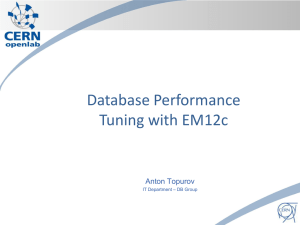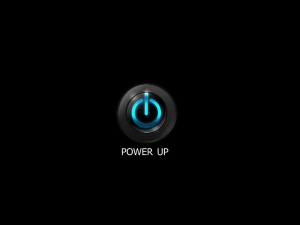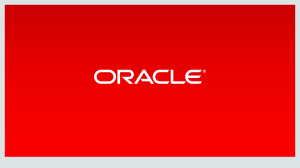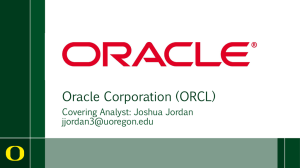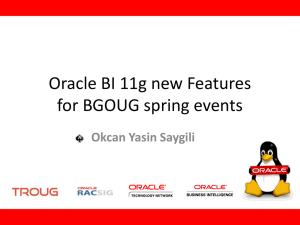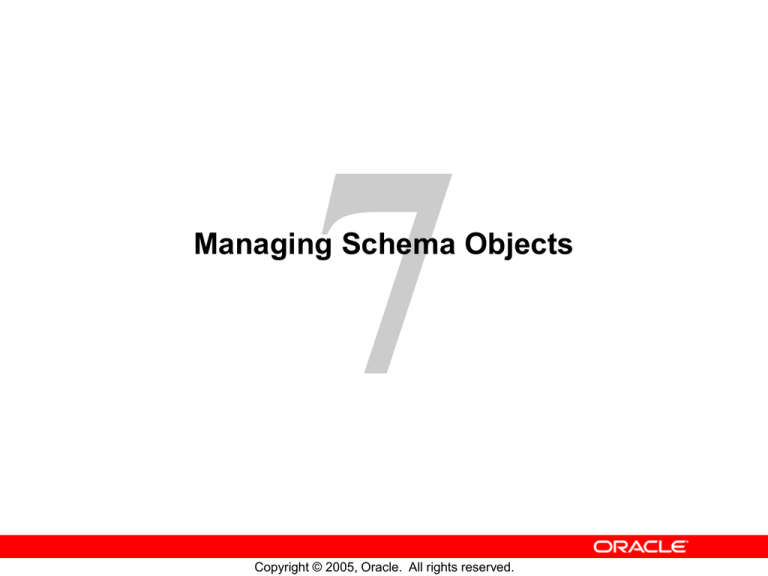
Managing Schema Objects
Copyright © 2005, Oracle. All rights reserved.
Objectives
After completing this lesson, you should be able to do
the following:
• Define schema objects and data types
• Create and modify tables
• Define constraints
• View the columns and contents of a table
• Create indexes
• Create views
• Create sequences
• Explain the use of temporary tables
• Use the data dictionary
7-2
Copyright © 2005, Oracle. All rights reserved.
What Is a Schema?
owns
HR schema
HR user
7-3
Copyright © 2005, Oracle. All rights reserved.
> Schema
Constraints
Indexes
Views
Sequences
Temp Tables
Data Dict
Accessing Schema Objects
7-5
Copyright © 2005, Oracle. All rights reserved.
Naming Database Objects
•
The length of names must be from 1 to 30 bytes,
with these exceptions:
– Names of databases are limited to 8 bytes.
– Names of database links can be as long as 128
bytes.
•
•
•
7-6
Nonquoted names cannot be Oracle-reserved
words.
Nonquoted names must begin with an alphabetic
character from your database character set.
Quoted names are not recommended.
Copyright © 2005, Oracle. All rights reserved.
Specifying Data Types in Tables
Common data types:
• CHAR(size [BYTE|CHAR]): Fixed-length
character data of size bytes or characters
• VARCHAR2(size [BYTE|CHAR]): Variable-length
character string having a maximum length of size
bytes or characters
• DATE: Valid date ranging from January 1, 4712 B.C.
through A.D. December 31, 9999
• NUMBER(p,s): Number with precision p and
scale s
7-8
Copyright © 2005, Oracle. All rights reserved.
Creating and Modifying Tables
Specify the table
name and schema.
Specify the column names,
data types, and lengths.
7-11
Copyright © 2005, Oracle. All rights reserved.
Understanding Data Integrity
DEPARTMENTS
JOB_HISTORY
EMPLOYEE_ID
(PK,FK)
START_DATE (PK)
END_DATE
JOB_ID (FK)
DEPARTMENT_ID (FK)
EMPLOYEES
EMPLOYEE_ID (PK)
FIRST_NAME
LAST_NAME
EMAIL
PHONE_NUMBER
HIRE_DATE
JOB_ID (FK)
SALARY
COMMISION_PCT
MANAGER_ID (FK)
DEPARTMENT_ID (FK)
DEPARTMENT_ID (PK)
DEPARTMENT_NAME
MANAGER_ID
LOCATION_ID (FK)
Schema
> Constraints
Indexes
Views
Sequences
Temp Tables
Data Dict
LOCATIONS
LOCATION_ID (PK)
STREET_ADDRESS
POSTAL_CODE
CITY
STATE_PROVINCE
COUNTRY_ID (FK)
COUNTRIES
JOBS
JOB_ID (PK)
JOB_TITLE
MIN_SALARY
MAX_SALARY
COUNTRY_ID (PK)
COUNTRY_NAME
REGION_ID (FK)
REGIONS
REGION_ID (PK)
REGION_NAME
7-13
Copyright © 2005, Oracle. All rights reserved.
Defining Constraints
7-15
Copyright © 2005, Oracle. All rights reserved.
Constraint Violations
Examples of how a constraint can be violated are:
• Inserting a duplicate primary key value
• Deleting the parent of a child row in a referential
integrity constraint
• Updating a column to a value that is out of the
bounds of a check constraint
ID
101
7-16
101
…
102
…
103
…
X
Copyright © 2005, Oracle. All rights reserved.
AGE
…
22
…
49
…
16
…
5
–30
Constraint States
DISABLE
NOVALIDATE
DISABLE
VALIDATE
ENABLE
NOVALIDATE
ENABLE
VALIDATE
No DML
New data
Existing data
7-17
Copyright © 2005, Oracle. All rights reserved.
Constraint Checking
Constraints are checked at the time of:
• Statement execution, for nondeferred constraints
• COMMIT, for deferred constraints
Case: DML statement, followed by COMMIT
7-19
1
Nondeferred constraints
checked
2
COMMIT issued
3
Deferred constraints checked
4
COMMIT complete
Copyright © 2005, Oracle. All rights reserved.
Creating Constraints with SQL: Examples
a
ALTER TABLE countries
ADD (UNIQUE(country_name) ENABLE NOVALIDATE);
b
ALTER TABLE employees ADD CONSTRAINT pk PRIMARY KEY
(employee_id)
c
7-20
CREATE TABLE t1 (pk NUMBER PRIMARY KEY, fk NUMBER, c1 NUMBER,
c2 NUMBER,
CONSTRAINT ri FOREIGN KEY (fk) REFERENCES t1,CONSTRAINT ck1
CHECK (pk > 0 and c1 > 0));
Copyright © 2005, Oracle. All rights reserved.
Viewing the Columns in a Table
7-21
Copyright © 2005, Oracle. All rights reserved.
Viewing the Contents of a Table
7-22
Copyright © 2005, Oracle. All rights reserved.
Actions with Tables
7-23
Copyright © 2005, Oracle. All rights reserved.
Dropping a Table
Dropping a table removes:
• Data
DROP TABLE hr.employees PURGE;
• Table structure
• Database triggers
• Corresponding indexes
• Associated object privileges
Optional clauses for the DROP TABLE statement:
• CASCADE CONSTRAINTS: Dependent referential
integrity constraints
• PURGE: No flashback possible
7-24
Copyright © 2005, Oracle. All rights reserved.
Truncating a Table
TRUNCATE TABLE hr.employees;
•
•
7-25
Truncating a table makes its row data unavailable,
and optionally releases used space.
Corresponding indexes are truncated.
Copyright © 2005, Oracle. All rights reserved.
Schema
Constraints
> Indexes
Views
Sequences
Temp Tables
Data Dict
Indexes
… WHERE key = 22
Key
Row
pointer
22
22
Index
7-26
Table
Copyright © 2005, Oracle. All rights reserved.
Types of Indexes
These are several types of index structures available
to you, depending on the need:
• A B-tree index is in the form of a binary tree and is
the default index type.
• A bitmap index has a bitmap for each distinct
value indexed, and each bit position represents a
row that may or may not contain the indexed
value. This is best for low-cardinality columns.
7-27
Copyright © 2005, Oracle. All rights reserved.
B-Tree Index
Index entry
Root
Branch
Index entry header
Leaf
Key column length
Key column value
ROWID
7-28
Copyright © 2005, Oracle. All rights reserved.
Bitmap Indexes
Table
File 3
Block 10
Block 11
Block 12
Index
Start End
Key ROWID ROWID
Bitmap
<Blue, 10.0.3, 12.8.3, 1000100100010010100>
<Green, 10.0.3, 12.8.3, 0001010000100100000>
<Red, 10.0.3, 12.8.3, 0100000011000001001>
<Yellow, 10.0.3, 12.8.3, 0010001000001000010>
7-30
Copyright © 2005, Oracle. All rights reserved.
Index Options
•
•
•
•
•
•
7-32
A unique index ensures that every indexed value
is unique.
An index can have its key values stored in
ascending or descending order.
A reverse key index has its key value bytes stored
in reverse order.
A composite index is one that is based on more
than one column.
A function-based index is an index based on a
function’s return value.
A compressed index has repeated key values
removed.
Copyright © 2005, Oracle. All rights reserved.
Creating Indexes
CREATE INDEX my_index ON
employees(last_name, first_name);
7-34
Copyright © 2005, Oracle. All rights reserved.
What Is a View?
LOCATION table
COUNTRY table
Schema
Constraints
Indexes
> Views
…
View
CREATE VIEW v AS SELECT location_id, country_name FROM
locations l, countries c
WHERE l.country_id = c.country_id AND c.country_id in
('AU','BR');
7-35
Copyright © 2005, Oracle. All rights reserved.
Creating Views
7-36
Copyright © 2005, Oracle. All rights reserved.
Sequences
Schema
Constraints
Indexes
Views
> Sequences
Temp Tables
Data Dict
A sequence is a mechanism for automatically
generating integers that follow a pattern.
1
• A sequence has a name, which is
2
3
how it is referenced when the next
4
5
value is requested.
• A sequence is not associated with
any particular table or column.
• The progression can be ascending or
descending.
• The interval between numbers can be of any size.
• A sequence can cycle when a limit is reached.
7-37
Copyright © 2005, Oracle. All rights reserved.
Creating a Sequence
7-38
Copyright © 2005, Oracle. All rights reserved.
Using a Sequence
7-40
Copyright © 2005, Oracle. All rights reserved.
Temporary Tables
Schema
Constraints
Indexes
Views
Sequences
> Temp Tables
Data Dict
A temporary table:
• Provides storage of data that is automatically
cleaned up when the session or transaction ends
• Provides private storage of data for each session
• Is available to all sessions for use without
affecting each other’s private data
7-41
Copyright © 2005, Oracle. All rights reserved.
Temporary Tables: Considerations
•
Use the GLOBAL TEMPORARY clause to create
temporary tables:
CREATE GLOBAL TEMPORARY TABLE employees_temp
ON COMMIT PRESERVE ROWS
AS SELECT * FROM employees;
•
•
Use the TRUNCATE TABLE command to delete the
contents of the table.
You can create the following on temporary tables:
– Indexes
– Views
– Triggers
7-43
Copyright © 2005, Oracle. All rights reserved.
Data Dictionary: Overview
Tables
Indexes
Views
Users
Schemas
Procedures
and so on
SELECT * FROM dictionary;
7-44
Copyright © 2005, Oracle. All rights reserved.
Schema
Constraints
Indexes
Views
Sequences
Temp Tables
> Data Dict
Data Dictionary Views
7-45
Who Can
Query
Contents
Subset of Notes
DBA_
DBA
Everything
N/A
May have additional
columns meant for DBA
use only
ALL_
Everyone
Everything
that the user
has
privileges to
see
DBA_
views
Includes user’s own
objects
USER_
Everyone
Everything
that the user
owns
ALL_
views
Is usually the same as
ALL_ except for the
missing OWNER column.
Some views have
abbreviated names as
PUBLIC synonyms.
Copyright © 2005, Oracle. All rights reserved.
Data Dictionary: Usage Examples
a
SELECT table_name, tablespace_name FROM
user_tables;
b
SELECT sequence_name, min_value, max_value,
increment_by FROM all_sequences WHERE
sequence_owner IN ('MDSYS','XDB');
c
SELECT USERNAME, ACCOUNT_STATUS FROM
dba_users WHERE ACCOUNT_STATUS = 'OPEN';
d
DESCRIBE dba_indexes;
7-47
Copyright © 2005, Oracle. All rights reserved.
Summary
In this lesson, you should have learned how to:
• Define schema objects and data types
• Create and modify tables
• Define constraints
• View the columns and contents of a table
• Create indexes
• Create views
• Create sequences
• Explain the use of temporary tables
• Use the data dictionary
7-48
Copyright © 2005, Oracle. All rights reserved.
Practice Overview:
Administering Schema Objects
This practice covers the following topics:
• Creating tables with columns
• Creating constraints:
– Primary Key
– Foreign Key
– Check constraint
•
7-49
Creating indexes
Copyright © 2005, Oracle. All rights reserved.


